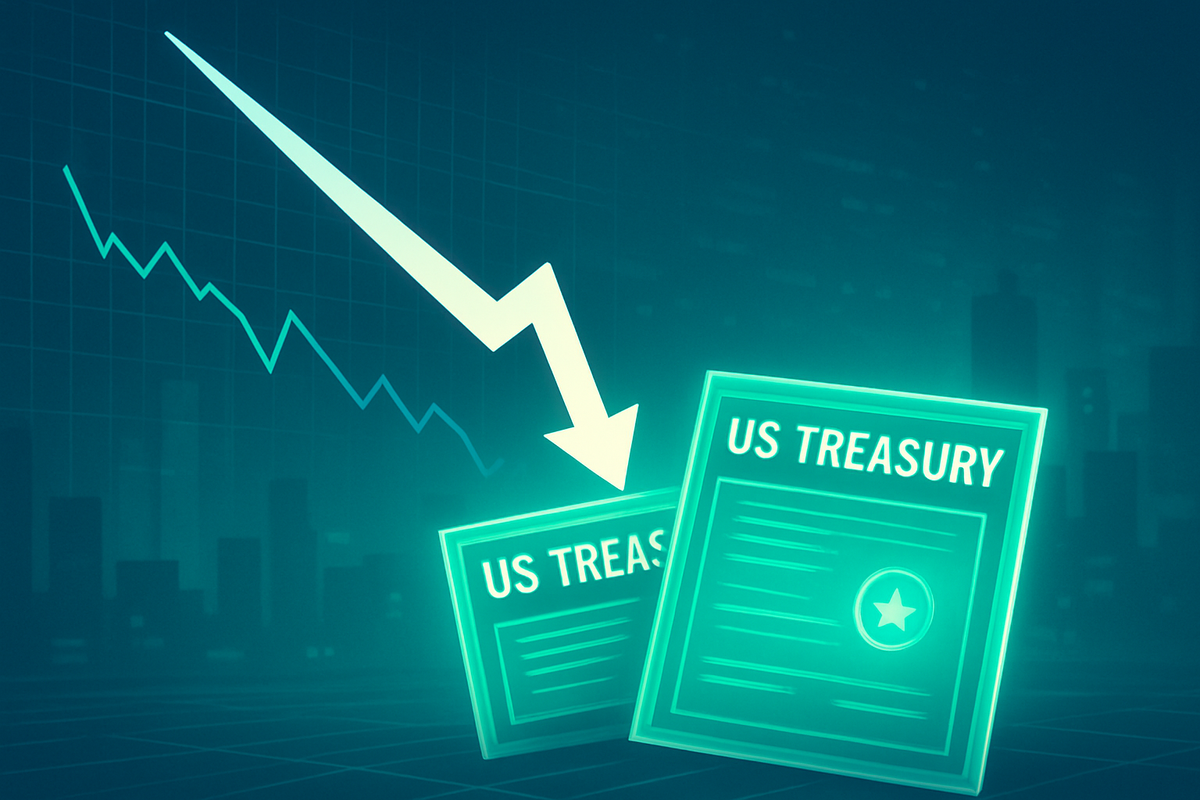
New York, NY – November 6, 2025 – The U.S. bond market is once again in the spotlight, with Treasuries experiencing a notable rally today, driven by renewed and aggressive bets on imminent interest rate cuts by the Federal Reserve. This latest surge in bond prices, which translates to falling yields, comes despite recent hawkish signals from the central bank, as fresh economic data pointing to a cooling labor market overrides previous uncertainties. The immediate implication is a significant shift in market sentiment, with investors now pricing in a higher probability of a December rate cut, potentially signaling a more accommodative monetary policy stance in the near future.
This rally marks a pivotal moment, as fixed income markets navigate a complex landscape shaped by the Federal Reserve's delicate balancing act between taming inflation and supporting economic growth. The bounce in Treasuries suggests that the market believes economic weakness, particularly in employment, will compel the Fed to ease monetary policy sooner and more aggressively than previously indicated. This could provide a much-needed tailwind for certain sectors of the economy, while also posing new challenges for others.
Unpacking the Treasury Bounce: A Closer Look at the Drivers
The current rally in U.S. Treasuries, observed prominently on November 5th and 6th, 2025, is primarily a reaction to recent bleak jobs data. This data has effectively reignited market expectations for a December rate cut by the Federal Reserve, overshadowing the somewhat less dovish tone from Fed Chair Jerome Powell following the late October FOMC meeting. During that meeting, the Fed delivered an expected 0.25% interest rate cut, bringing the fed funds rate to a range of 3.75%-4.0%. However, Powell's commentary at the time had introduced uncertainty, explicitly stating that a December cut was "not a foregone conclusion" and highlighting "strongly different views" within the FOMC. This initially led to a paradoxical rise in Treasury yields, as aggressive rate cut expectations were pared back.
The narrative quickly shifted with the emergence of new labor market indicators. Reports from early November, including a Challenger, Gray & Christmas Inc. report detailing the most job cuts for any October in over 20 years, have provided compelling evidence of a cooling U.S. labor market. While the October ADP employment figures showed a modest rebound, other indicators like the employment index within the ISM Services PMI remaining below 50 for five consecutive months, signal ongoing hiring restraint. Goldman Sachs Research has also pointed to "genuine" weakness in the U.S. job market as a reason to expect a December rate cut.
Adding to the complexity is the ongoing U.S. government shutdown, which has severely hampered the release of official economic data. This scarcity of comprehensive information has forced investors and policymakers to rely more heavily on private sector reports and anecdotal evidence, contributing to market volatility and making forecasting more challenging. Despite this, the overwhelming sentiment from the latest jobs data has been sufficient to tilt the scales back towards aggressive rate cut expectations, with Treasuries responding by rallying as yields fall.
Corporate Fortunes: Winners and Losers in a Rate-Cut Environment
The prospect of declining interest rates typically creates a clear divide between corporate winners and losers. Companies that are highly sensitive to borrowing costs or consumer spending patterns often see their fortunes shift dramatically.
In a rate-cutting environment, growth stocks, particularly in the technology sector, tend to thrive. Lower interest rates reduce the cost of capital, making it cheaper for companies to fund expansion and innovation. Furthermore, lower discount rates make future earnings, which are often projected far out for growth companies, appear more valuable today. Tech giants like Apple (NASDAQ: AAPL), Microsoft (NASDAQ: MSFT), and Amazon (NASDAQ: AMZN), which rely on investment for R&D and often carry debt for large-scale projects, could see their profitability boosted. Similarly, real estate investment trusts (REITs) and homebuilders like D.R. Horton (NYSE: DHI) often benefit as lower mortgage rates stimulate housing demand and reduce financing costs for property development.
Conversely, sectors traditionally favored in high-rate environments may face headwinds. Financial institutions, particularly banks, often see their net interest margins (NIM) squeezed when rates fall. While lower rates can stimulate loan demand, the compression in the spread between what banks earn on loans and what they pay on deposits can reduce profitability. Major banks such as JPMorgan Chase (NYSE: JPM) and Bank of America (NYSE: BAC) might experience pressure on their earnings. Additionally, utility companies, often seen as bond proxies due to their stable dividends, may become less attractive as bond yields fall, diminishing their relative appeal for income-seeking investors. Companies with high levels of floating-rate debt, however, could see their interest expenses decrease significantly, improving their bottom line.
Wider Implications: Navigating Broader Economic Currents
The anticipated shift towards a more accommodative monetary policy, spurred by a weakening labor market, carries significant wider implications for the broader economy and financial markets. This event fits into a global trend where central banks are grappling with the lingering effects of past inflationary pressures while simultaneously monitoring signs of economic deceleration. Should the Federal Reserve proceed with rate cuts, it would signal a pivot from its earlier inflation-fighting stance to one more focused on supporting growth and employment, a move that could be mirrored by other global central banks if their economies show similar signs of stress.
Potential ripple effects could be felt across various sectors. For instance, a sustained period of lower interest rates could reignite activity in the housing market, benefiting not just builders but also related industries like home furnishings and appliances. Conversely, the dollar could weaken against other major currencies as the interest rate differential narrows, making U.S. exports more competitive but potentially increasing import costs. Regulatory bodies will also be closely watching, as a loosening of monetary policy might prompt discussions about the stability of financial markets and potential asset bubbles, especially if liquidity becomes abundant. Historically, periods of rapid rate cuts have often followed economic downturns or significant market stresses, such as the early 2000s dot-com bust or the 2008 financial crisis. While the current situation is distinct, the Fed's proactive stance in response to economic data echoes past efforts to avert deeper recessions, highlighting the central bank's critical role in steering the economy. The ongoing government shutdown further complicates this picture, as policymakers are forced to make decisions with incomplete data, adding another layer of uncertainty to the market's trajectory.
What Comes Next: Navigating the Path Forward
The immediate future for the bond market and the broader economy hinges critically on the Federal Reserve's next moves. Short-term possibilities include increased volatility in Treasury yields as market participants keenly await the Fed's December meeting and any further economic data releases, particularly those related to inflation and employment, once the government shutdown concludes. If the Fed does indeed cut rates in December, as increasingly priced in by the market, it could solidify a trend of lower borrowing costs, potentially boosting consumer spending and corporate investment in the early months of 2026. Goldman Sachs Research, for example, not only anticipates a December rate cut but also two more in early 2026, suggesting a more prolonged easing cycle.
In the long term, companies may need to adapt their strategic pivots to a lower-rate environment. Businesses with significant debt could consider refinancing at more favorable terms, freeing up capital for growth initiatives or shareholder returns. Sectors like renewable energy and infrastructure, which often require substantial upfront capital investment, could find it easier to secure financing, leading to accelerated development. However, market opportunities also come with challenges. Investors will need to reassess their portfolios, potentially shifting away from traditional income-generating assets towards growth-oriented investments, while also being mindful of potential inflation re-acceleration if the Fed eases too aggressively. Potential scenarios range from a "soft landing" where the economy avoids a recession due to timely rate cuts, to a more challenging environment if the underlying economic weakness is more profound than anticipated, necessitating even deeper cuts.
Comprehensive Wrap-up: A Market in Transition
The recent rally in Treasuries, fueled by aggressive rate cut expectations stemming from weakening jobs data, underscores a critical juncture for the U.S. financial markets. The key takeaway is that the market is increasingly convinced the Federal Reserve will prioritize economic support over its previous hawkish stance, especially in the face of a cooling labor market and a data vacuum created by the government shutdown. This represents a significant shift from just a few weeks ago when Fed Chair Powell's comments had tempered enthusiasm for immediate easing.
Moving forward, the market will remain highly sensitive to every piece of economic data, particularly labor market reports and inflation figures, as investors attempt to divine the exact timing and magnitude of future Fed actions. The assessment of the market is one of transition, from a period dominated by inflation fears and aggressive tightening to one grappling with the implications of easing monetary policy. Investors should watch closely for further commentary from Fed officials, the resolution of the government shutdown and subsequent release of official economic data, and any signs of how lower interest rates are translating into real economic activity. The coming months will be crucial in determining whether this bond market rally is the precursor to a sustained period of economic recovery or merely a temporary reprieve in a more challenging landscape.
This content is intended for informational purposes only and is not financial advice







